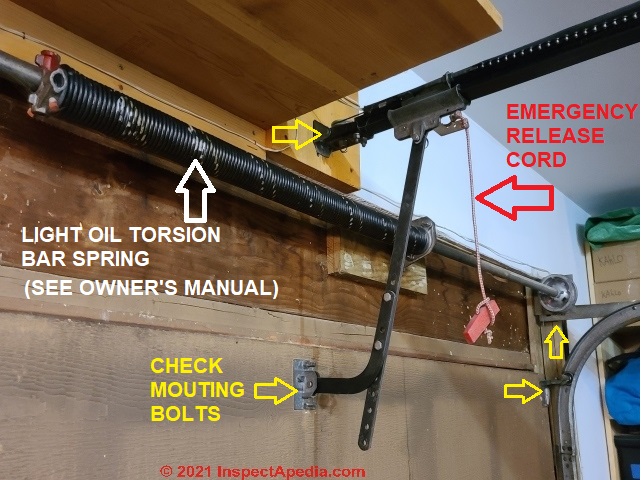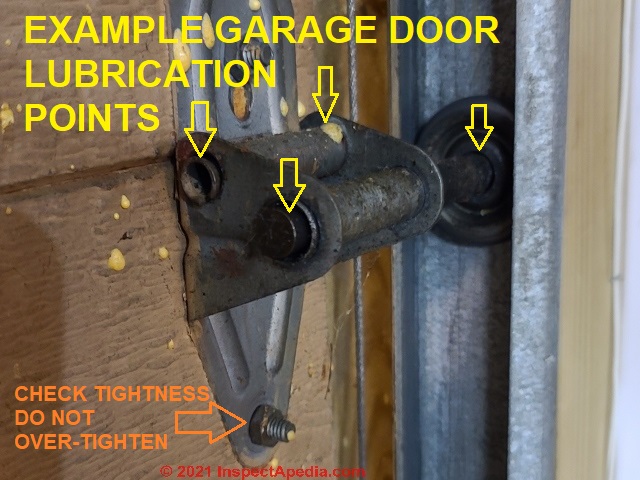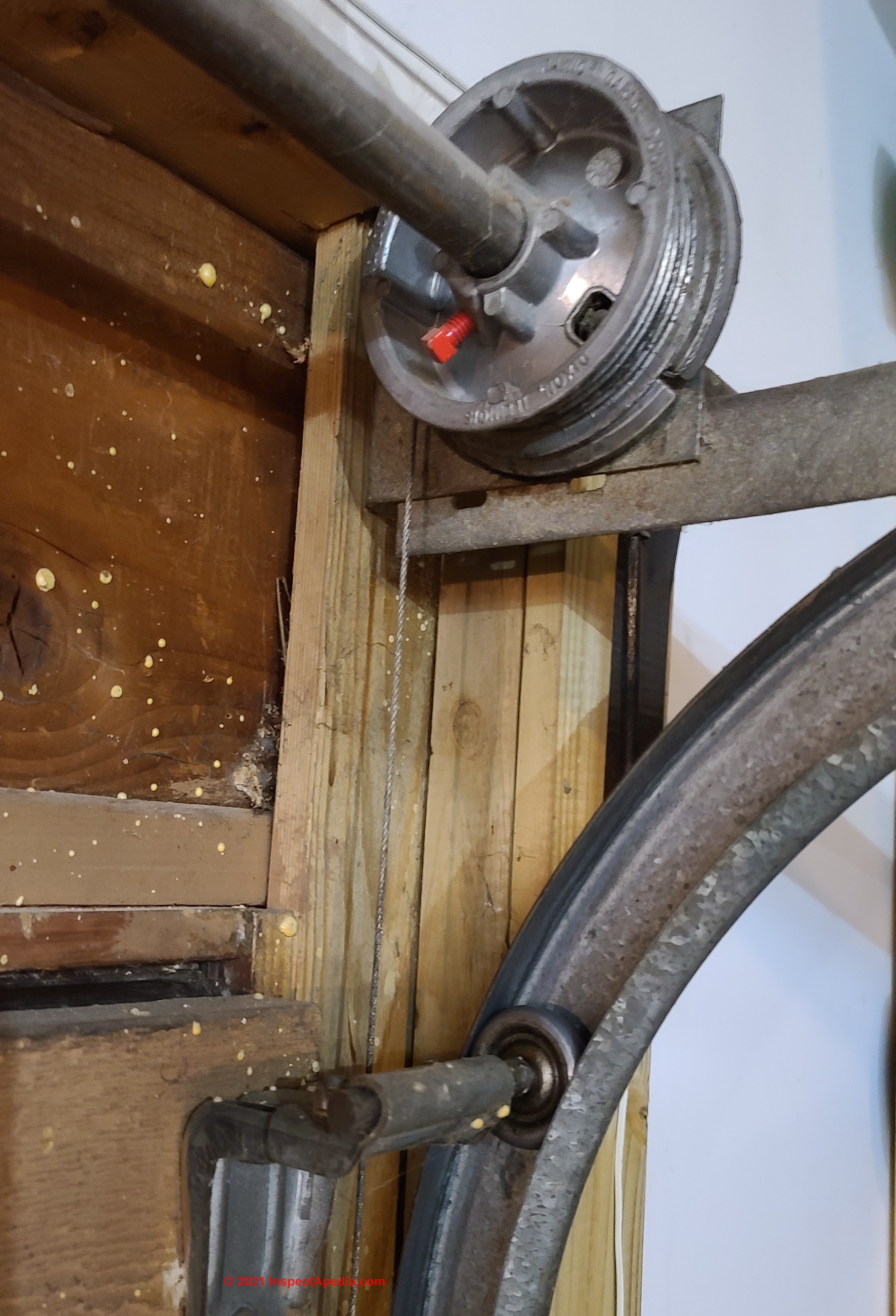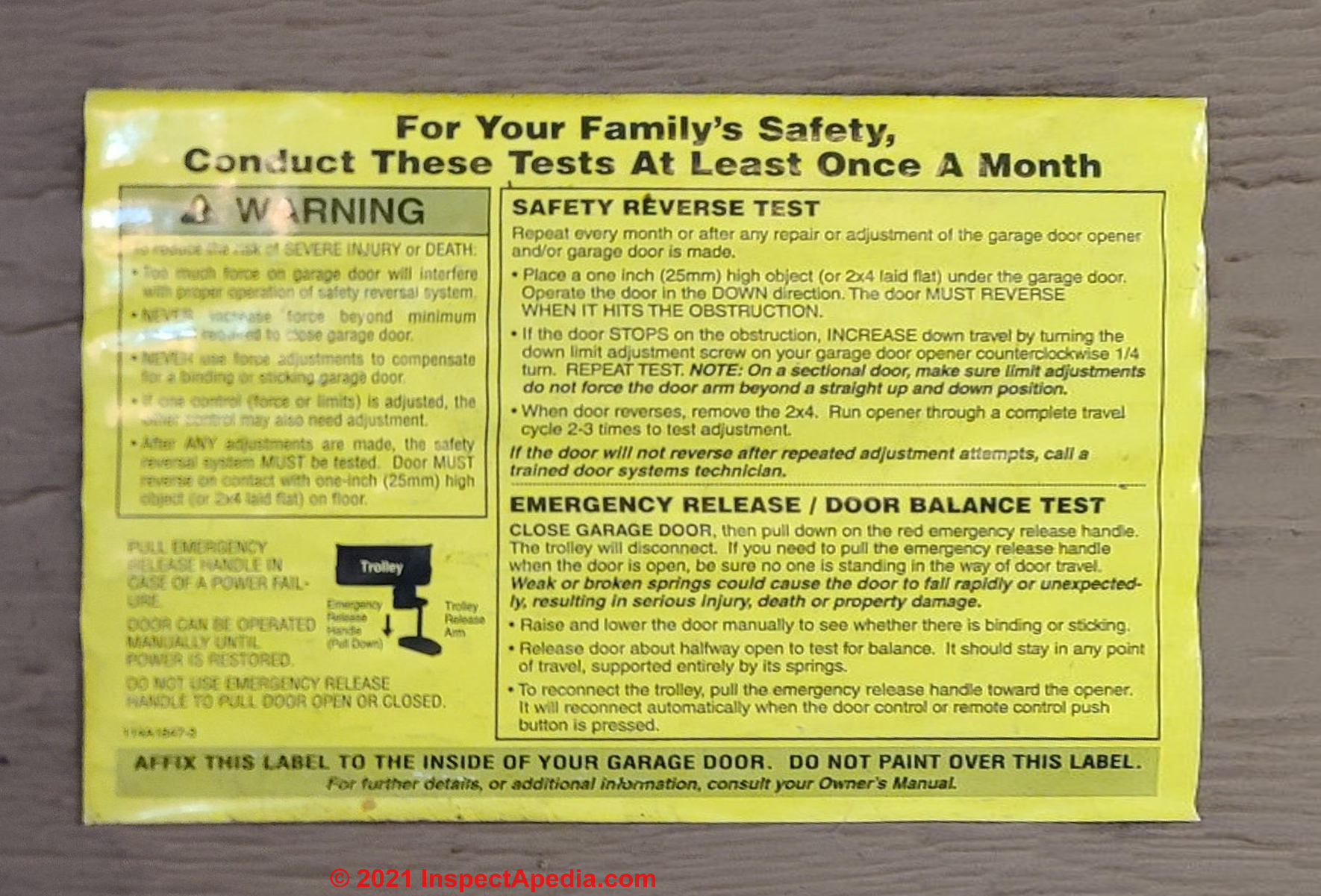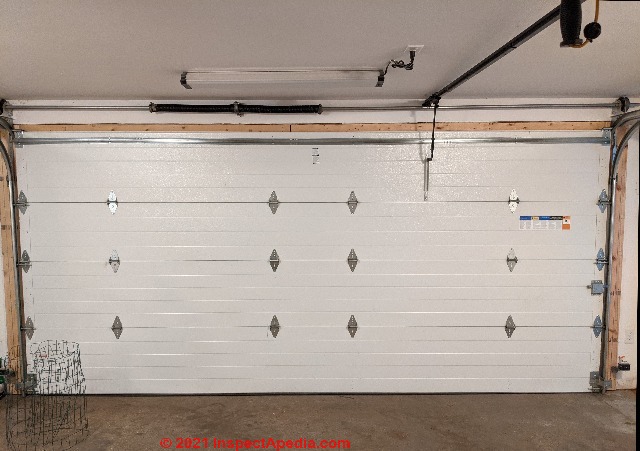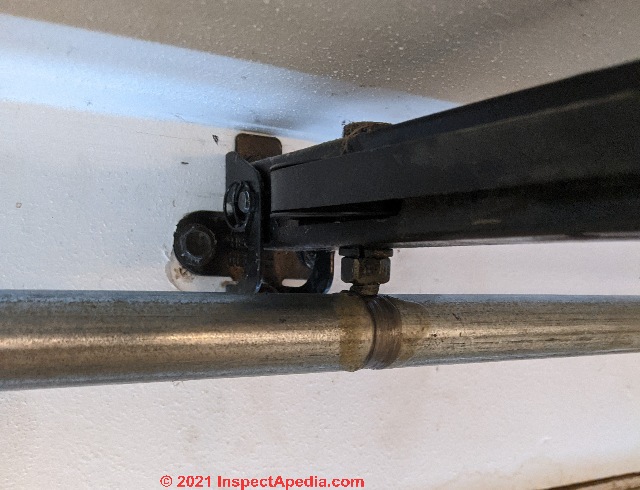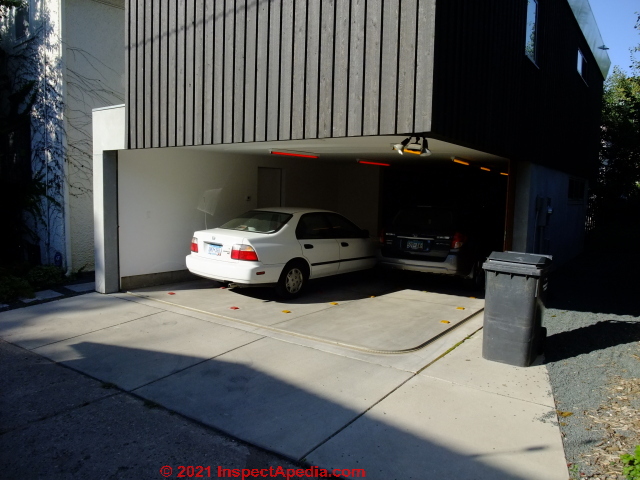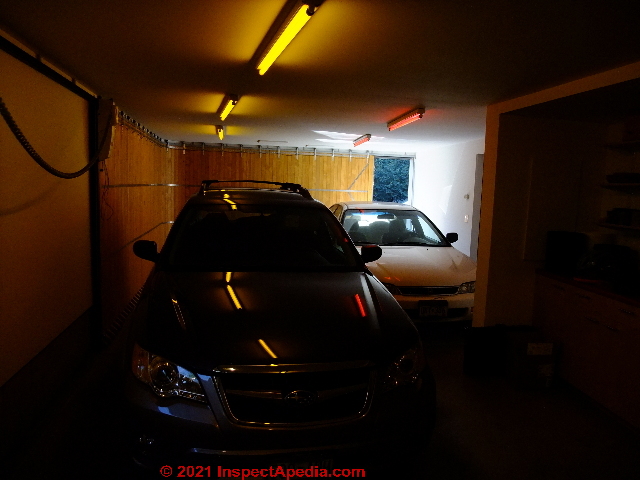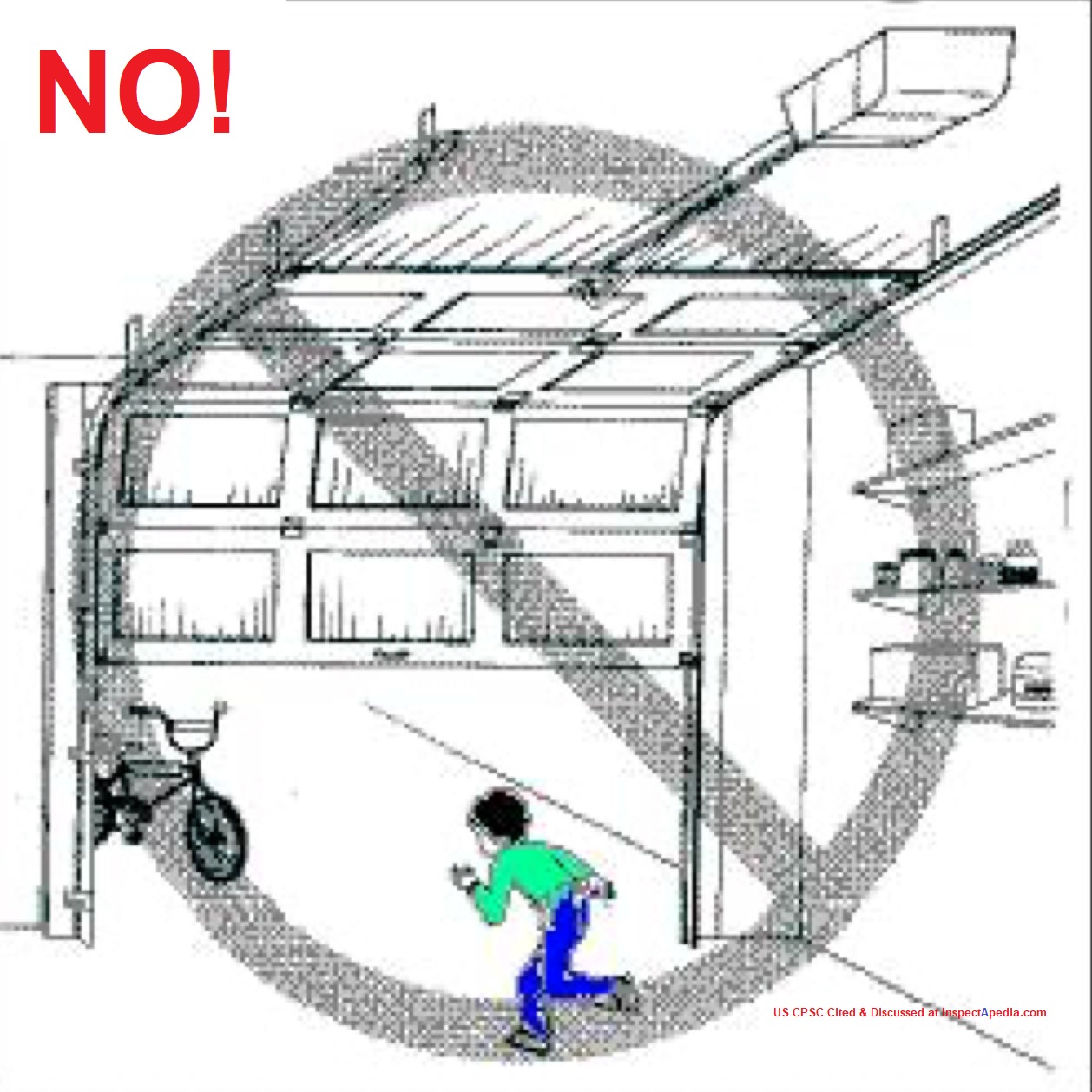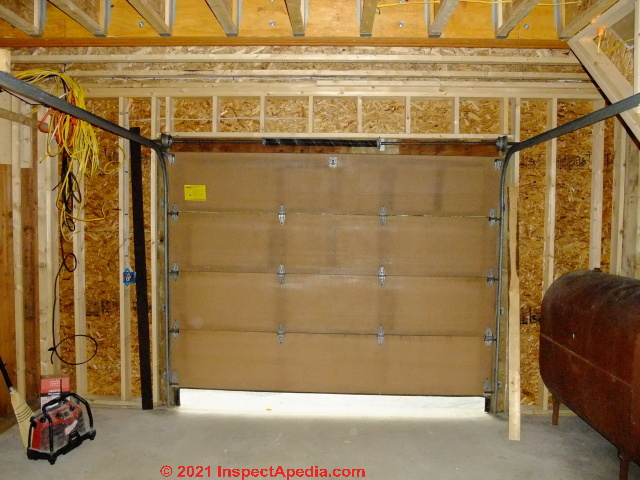 Garage Door Safety & Repair
Garage Door Safety & Repair
Install, Inspect, Repair & Maintain garage doors & door operators
- POST a QUESTION or COMMENT about garage doors and garage door safety
This article describes safety hazards and safety inspection points for vehicle doors, automatic garage door operators, and also garage passage doors or man-doors giving access between a garage and the building interior.
Page top photo: a typical spring-operated torsion-type garage-door operator mechanism during re-construction of a New York garage. A center spring is wound as the door moves downward.
The spring tension provides a lift-assist for either a manually-operated garage door or for an automatic garage door operator (in our photo the automatic operator is not yet installed).
An improperly-installed or adjusted or obsolete automatic garage door operator is unsafe because it can injure or even kill a child, while access doors between a garage and the building that it serves have their own separate set of safety requirements including fire-resistance, automatic-closing mechanisms, measures to prevent vehicle exhaust or fumes from entering the building, and proper walking surfaces to avoid fall-hazards.
InspectAPedia tolerates no conflicts of interest. We have no relationship with advertisers, products, or services discussed at this website.
- Daniel Friedman, Publisher/Editor/Author - See WHO ARE WE?
Garage Door Safety Hazards
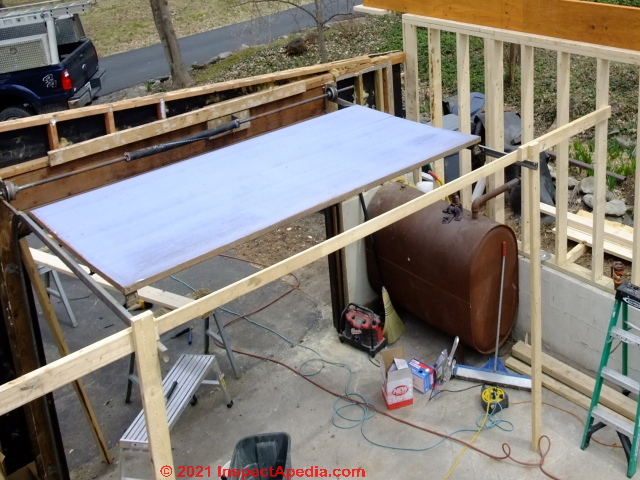 Our photo above shows an automatic garage door operator and the door itself, in a view not normally available: from above, during reconstruction of a New York garage.
Our photo above shows an automatic garage door operator and the door itself, in a view not normally available: from above, during reconstruction of a New York garage.
You can see the center spring, torsion bar, and the tracks through which wheels on the garage door segments run as the door moves up or down.
[Click to enlarge any image]
Following our list and discussion of safety hazards at manual and automatic garage vehicle doors or overhead doors, we include a list of hazards at garage passage doors between garage and building.
Garage Vehicle Door Hazards Inspection List
- Obsolete garage door operator:
Automatic garage door operator that is an obsolete model that lacks an automatic reversing safety mechanism (In the U.S., older than 1982) - Mis-Adjusted:
Automatic garage door operator whose safety mechanism is not properly adjusted to reverse if it detects an obstruction: misaligned sensor lights or improperly-adjusted obstruction sensor.
Object impact detection system:
The garage door should reverse on striking any object within 1 1/2" of the floor surface or higher. Required on garage door operators made after 1981.
External entrapment protection system:
The garage door should reverse if it detects any object beneath the door path even without striking the object (typically by optical sensors that must be aligned properly). Required on garage door operators made after 1 January 1993.
Optical sensors are usually mounted 4-6" above the garage floor. - Child-access to door controls:
Automatic garage door operator control switch mounted too low - accessible to small children (attractive nuisance)
Also keep remote garage door operator controls out of the reach of children. - Weak, loose operator motor mounts: Garage door or door operator motor or parts not securely mounted to the building structure: falling risk
- Automatic garage door operator spring(s) improperly-adjusted,
door out of balance: door should remain in position if stopped during movement - Automatic garage door operator improperly-adjusted
if the door re-opens on its own after closing fully:
homeowner thinks s/he has closed it and drives away, leaving the building open to pests or forming a building security risk - Automatic garage door wheels / track out of alignment,
can cause the door to jam, operator to fail, door to fall entirely out of its tracks, etc. - Overhead garage door tracks not securely-mounted
to the structure: entire door assembly can fall when in the open position.
All door hardware: check for loose parts, bolts, fasteners at handles, step plates, hinges, top fixtures, locks, track brackets. Don't over-tighten as you may strip threads.
- Missing emergency release pull cord.
Pulling this cord disengages the trolley, allowing manual lifting of a closed door.
The primary pull cord function is to escape from the garage without assistance from the garage door operator during a power failure or other malfunction.
Pulling the cord also permits verification that the spring(s) and other components are properly adjusted and working smoothly.
This verification is important after repairs or adjustments and should be performed routinely, probably annually.
- Overhead garage door left disconnected
from its operator mechanism: heavy garage door may fall during manual effort to open or close it - Sliding or gate-type automatic garage door that lacks obstruction sensors
Additional garage door hazards for which automatic protection mechanisms either are not provided or can not be provided at low cost.
These are in addition to crushing injuries and fractures that occur to children and ascribed to absence or malfunction of the garage door safety hazards listed just above
- Garage door lubrication failures
can cause door cables or springs or the operator chain to break, also resulting in property damage or injury.
Typical overhead garage door maintenance, inspection & lubrication are required to maintain a safe garage door opening and closing system:
Door tracks: keep clean of grease and debris;
Door rollers: lightly-oil hinge points. steel roller stems, inner race assembly, locking device moving parts, torsion spring torsion tube, spring coil surfaces, using 30W or other minimum weight oil; wipe off excess;
See the garage door installation and operation manuals given below on this page for more details about garage door operator lubrication requirements. - Amputation or laceration hazards:
fingers, hands, or other body parts may be cut or even amputated if a person's hand or un-protected foot is inserted into dangerous locations such as in the wheel track of the garage door or into the garage door lift cable assembly.
Watch out: Photo above: the garage door lift cable, pulley surfaces, and wheels and track are all exposed in a normal overhead door installation. Keep fingers, hands, toes, clothing away from these opening!
- Impact or other injuries:
from pieces of broken garage door springs. Springs are more-likely to break when old (metal fatigue), rusted, or improperly-adjusted (over-stretched horizontal springs or over-wound torsion-bar springs).
Horizontal garage door lift assist springs
connected between the lift cables at each side of the door and the inner-most end of the garage door track can break suddenly, usually at the half-round connectors found at either end of the spring, allowing the garage door to fall suddenly.
We have inspected homes that sported a hole smashed in the garage wall opposite the garage door track, caused when the door spring broke and flew through the air.
Torsion bar garage door springs
that wrap around a torsion-bar type garage door lift assist spring can break suddenly. Lubrication and inspection are key to avoiding this damage. - Garage door spring hazards:
Watch out: do not try to remove, install, repair or adjust springs or anything to which the garage door parts are fastened such as wood blocks, steel brackets, cables, etc.
Repairs must be done by a trained garage door technician. If you are not trained to do so, attempting to remove a cable or adjust or remove a spring can cause serious injury.
These parts are under tremendous spring tension and can snap, break apart, and cause bodily injury if you attempt to loosen, move, or adjust them.
- Missing garage door safety labels:
factory-supplied garage door safety labels are provided for as many as seven different garage door hazards, depending on where you live.
These labels have required locations so that important safety warnings can be observed by the homeowner and others. Examples of garage door safety labels include
Operator bracket warning label
Torsion spring tag warning label (one per spring)
Cleaning instructions label
Residential safety warning label
Door bottom section safety warning labels
Door instruction manual & manual envelope - OPINION: Garage door operators that do not comply with voluntary ANSI/UL Standard 325-1982 are unsafe.
Unsafe Torsion-bar Type Garage Door Operator
Depending on its construction materials, a double-wide overhead garage door like the one in this photo can be particularly heavy.
Thanks to an InspectApedia reader we have these photographs of a damaged torsion-bar type garage door operator that is unsafe.
Should the gouged, damaged torsion bar break (or should the spring itself break) the garage door can come crashing down, injuring anyone who is below the door, or causing property damage.
Watch out: this is dangerous: the end of the track bolt above the rotating garage door operator pipe or bar has so gouged into the pipe that there is risk of its eventual breakage: releasing the torsion spring and sending the door crashing down.
Horizontal or Moving Gate Garage Vehicle Door Operators
Above and below, installed in a Minneapolis MN home, we see a long garage door that moves horizontally to open or close two sides of a garage to permit vehicles to use the garage from an otherwise difficult alley-access.
Gate type door operators also need a safety mechanism to detect an obstruction anywhere in the sliding door's passage, so that injury or property damage can be prevented.
Garage Passage Door of "Man Door" Safety
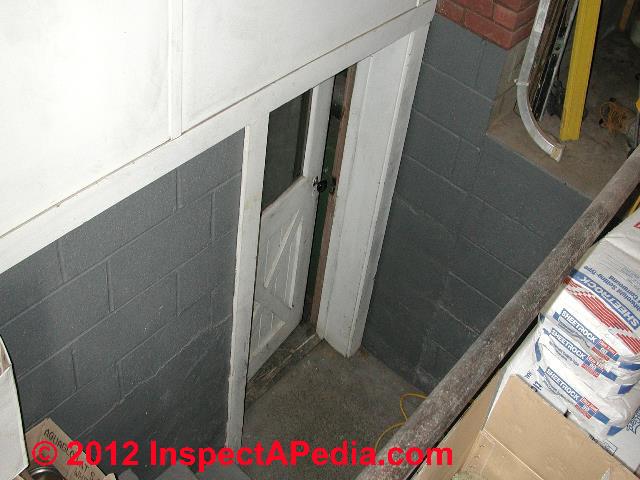 In-Garage Stairs to Basement = explosion waiting to happen
In-Garage Stairs to Basement = explosion waiting to happen
Our photo illustrates an unsafe entry stair passing from a residential garage into the home's basement:
a stairway originating on the garage floor passes down into the building's basement.
Watch out: As heating equipment is most often found in the home's basement, imagine the explosion that may occur (one did, despite our emphatic warnings, in Fishkill NY) if a vehicle leaks gasoline and gasoline fumes into the garage.
Gasoline fumes, heavier than air, fall down the stairwell, into the basement (or crawl space) where, at the next spark or flame, there is risk of an explosion.
A "fire door" in the stairwell bottom is not enough security for this installation. In fact, as you can see, the (not fire-rated) door has been left ajar.
The above is excerpted
from BASEMENT WALKOUTS & COVERS
Garage Passage Door Hazards & Safety Inspection Points
- Garage passage door not fire rated
or exterior type - building and fire codes require a fire-rated door between the garage and the building interior (and other fire-resistant measures as well, such as fire-rated walls between garage and building interior) - Garage passage door not tight-fitting
and weather stripped - risking leaks of fatal carbon monoxide (CO) if a vehicle is left running in the garage - No garage passage door automatic self-closing mechanism
- risking leaks of fatal carbon monoxide (CO) if a vehicle is left running in the garage and risking fire spread should a fire occur in the garage - No step up from garage floor to building interior
- risking leaks of fatal carbon monoxide (CO) if a vehicle is left running in the garage - Garage floor includes stairs down
into basement utility area (heating equipment) or occupied space (CO hazards) - Garage passage door opens into bedroom
- risking leaks of fatal carbon monoxide (CO)
Garage Vehicle Door Safety Notices, Standards Codes & Installation Manuals
Illustration: adapted from US CPSC Safety Alert cited just below.
Do children actually play a game of running out beneath a garage door that is in the process of closing. Absolutely. One of our clients described her small son and his friends playing a game of seeing who could wait longest to throw himself down and then roll out beneath the closing garage door!
- ANSI / UL Standards relevant to garage door operators and entrapment incidents include
UL196
ANSIU / UL 325 - ANSI/CAN/UL Standard for Door, Drapery, Gate, Louver, and Window Operators and Systems - safety standard for door, drapery, gate, louver, and window operators and systems.
It applies to electric operators for doors, draperies, gates, louvers, windows and other opening and closing appliances rated 600 volts or less. - Available at https://standardscatalog.ul.com/ProductDetail.aspx?productId=UL325
For further information concerning ANSI/UL 325 Standard for Safety for Door, Drapery, Gate, Louver, and Window Operators and Systems, please contact Joe Musso at Joseph.R.Musso@us.ul.com - Clopay, GARAGE DOOR INSTALLATION MANUAL [PDF] (2020) Clopay Corporation, Tel: 1-800-225-6729, retrieved 2021/06/30 original source: https://images.homedepot-static.com/catalog/pdfImages/cb/cb731140-8ff6-47eb-b3c4-ea4b986918bb.pdf
- CPSC, GARAGE DOOR OPERATORS / GATE OPERATORS [PDF] (2004) Regulations, Laws, Standards, U.S. Consumer Product Safety Commission, retrieved 2021/-6/29 original source: https://www.cpsc.gov/Regulations-Laws--Standards/Voluntary-Standards/Topics/Garage-Door-OperatorsGate-Operators
Excerpt: The U.S. Consumer Product Safety Commission (CPSC) staff participates in the Underwriters Laboratories, Inc. (UL) Standards Technical Panel (STP) for ANSI/UL 325, Safety for Door, Drapery, Gate, Louver, and Window Operators and Systems. CPSC staff participation allows us to provide input into changes to the voluntary standard and the associated CPSC mandatory safety rule (16 CFR part 1211), and to provide the Commission with the earliest possible notification of proposed changes to the rule.
The Consumer Product Safety Improvement Act of 1990 (Improvement Act) mandated that automatic residential garage door operators (GDOs) manufactured on or after January 1, 1991 conform to the entrapment protection requirements of the 1988 version of UL 325.
On June 19, 1991, the Commission issued the garage door operator standard (16 CFR Part 1211). - CPSC, SAFETY ALERT: NON-REVERSING AUTOMATIC GARAGE DOOR OPENERS ARE A HAZARD [PDF], (un-dated) CPSC Publication - 523 Non-Reversing Automatic Garage Door Openers U.S. Consumer Product Safety Commission, - retrieved 2021/06/2,9 original source: https://www.cpsc.gov/s3fs-public/garage.pdf
Excerpts:
Homeowners with automatic garage door openers that do not automatically reverse should repair or replace them with new reversing openers. This prevents young children from being trapped and killed under closing garage doors.
According to reports received by the U.S. Consumer Product Safety Commission (CPSC), about 73 children between the ages of 2 and 14 have been trapped and killed under automatic garage doors since March 1982.
This is about three such deaths per year on average. Other children have suffered brain damage or serious injuries when the closing door hit them, and failed to stop and reverse its direction. - CPSC, UPDATE OF AUTOMATIC GARAGE DOOR AND GARAGE DOOR OPENERS ENTRAPMENT INCIDENTS TO CHILDREN UNDER 15 YEARS OF AGE Reported to CPSC Between December 1, 1996 and June 30, 2003 [PDF] US CPSC, retrieved 2021/06/29 original source: https://www.cpsc.gov/s3fs-public/pdfs/blk_media_gdoupdate.pdf
- Safety Standard for Automatic Residential Garage Door Operators (US Consumer Product Safety Commission Regulation) (CPSC) (2018 Edition) Paperback – July 6, 2018 [availble from book-sellers and Amazon]
- DASMA, Door & Access Systems Manufacturing Association,
1300 Sumner Ave, Cleveland, OH 44115 *SA, Website: https://www.dasma.com/ Tel: 216-241-7333 Email: dasma@dasma.com
Website excerpt: North America's leading trade association of manufacturers of garage doors, rolling doors, high performance doors, garage door openers, vehicular gate openers, and access control products.
- Devanco, RESIDENTIAL GARAGE DOOR OPENER INSTALLATION MANUAL [PDF] Devanco Canada, 19192 Hay Road, Unit Q, Summerstown, On K0C 2E0 Canada, Tel: 855-931-3334 Website: www.devancoanada.com
- Garaga, GARAGA CARRIAGE GARAGE DOOR INSTALLATION MANUAL [PDF] 8500, 25th Avenue, St-Georges, QC Canada G6A 1K5 Tel.: 418 227-2828 Email: info@garaga.com Website: www.garaga.com
- GARAGE DEFECTS LIST [Web Article] lists other garage door defects and hazards
- IRC, International Residential Code
Excerpts:
2006 International Residential Code (IRC)
R309.1 Opening Protection:Openings from a private garage directly into a room used for sleeping purposes shall not be permitted.
Other openings between the garage and the residence shall be equipped with solid wood doors not less than 1-3/8” (35 mm) in thickness, solid- or honeycomb-core steel doors not less than 1-3/8” (35 mm) thick, or 20-minute fire-rated doors.
R309.2: Separation Requirements:
The garage shall be separated from the residence and its attic area by not less than 1/2-inch (12.7 mm) gypsum board applied to the garage side.
Garages beneath habitable rooms shall be separated from all habitable rooms above by not less than 5/8-inch (15.9 mm) Type X gypsum board or equivalent. Where the separation is a floor-ceiling assembly, the structure supporting the separation shall also be protected by not less than 1/2-inch (12.7 mm) gypsum board or equivalent.
Garages located less than 3 feet (914 mm) from a dwelling unit on the same lot shall be protected with not less than 1/2–inch (12.7 mm) gypsum board applied to the interior side of exterior walls that are within this area.
Openings in these walls shall be regulated by Section 309.1.
This provision does not apply to garage walls that are perpendicular to the adjacent dwelling unit wall.
- Liftmaster, COMMERCIAL GARAGE DOOR OPERATOR INSTALLATION MANUAL [PDF] (2016) Models T, APT, H, J, HJ, GH, and GT, Liftmaster, retrieved 2021/06/30, original source: http://www.rsoperators.com/v/vspfiles/downloadables/L5_Installation_Manual.pdf
- Linear, BELT or CHAIN DRIVE GARAGE DOOR OPERATOR INSTALLATION MANUAL [PDF] (2010) Models LDO33 & LDO50, Linear, LLC, USA & Canada (800) 835-5666 & (800) 421-1587 Website: www.linearcorp.com, retrieved 2021/06/30 original source:
- Overhead Door, CARRIAGE HOUSE DOOR OPERATOR MANUAL [PDF] (2015) Overhead Door Corporation, Tel: 1-800-929-DOOR Website: www.OverheadDoor.com
- Overhead Door, HOMEOWNER'S GARAGE DOOR MANUAL (Steel Doors) [PDF] (2020) Op. Cit.
- Overhead Door, HOMEOWNER'S GARAGE DOOR MANUALL (Wood Doors) [PDF] (2010) Op. Cit., retrieved 2021/06/29 original source: https://www.overheaddoor.com/Documents/wood-garage-doors-owners-manual.pdf
- Public Resource.org, COMMENT ON SAFETY STANDARD FOR AUTOMATIC RESIDENTIAL GARAGE DOOR OPERATORS [PDF] (2015), Public.Resource.Org
1005 Gravenstein Highway North
Sebastopol, CA 95472-2811, USA
United States
Docket Number: CPSC-2015-0025 retrieved 2021/06/29 original source: https://law.resource.org/pub/us/cfr/regulations.gov.docket.15/cpsc.gov.20151116.html
Additional statistics on injuries ascribed to garage doors or garage door operators, the writers ask that the voluntary garage door safety standards be made mandatory. - U.S. Federal Regulations, 16 CFR PART 1211 SAFETY STANDARD FOR AUTOMATIC RESIDENTIAL GARAGE DOOR OPERATORS [PDF] (2018) United States Code of Federal Regulations, 16-part 1211
Excerpts:
SUMMARY: The Consumer Product Safety Commission (Commission, or CPSC) is amending its regulation, Safety Standard for Automatic Residential Garage Door Operators, to reflect changes made by Underwriters Laboratories, Inc. (UL), in the entrapment protection provisions in UL’s standard UL 325, Standard for Safety: Door, Drapery, Gate, Louver, and Window Operators and Systems, Seventh Edition.
...
Homeowners with automatic garage door openers that do not automatically reverse should repair or replace them with new reversing openers. This prevents young children from being trapped and killed under closing garage doors.
According to reports received by the U.S. Consumer Product Safety Commission (CPSC), about 73 children between the ages of 2 and 14 have been trapped and killed under automatic garage doors since March 1982.
This is about three such deaths per year on average. Other children have suffered brain damage or serious injuries when the closing door hit them, and failed to stop and reverse its direction. - U.S. Federal Regulations, 16 CFR PART 1211 SAFETY STANDARD FOR AUTOMATIC RESIDENTIAL GARAGE DOOR OPERATORS [PDF] (2016) [Older version of the above] United States Code of Federal Regulations, 16-part 1211
Excerpt:
SUMMARY:
The Consumer Product Safety Commission (‘‘Commission’’ or ‘‘CPSC’’) is issuing a final rule amending the regulations for the Safety Standard for Automatic Residential Garage Door Operators to reflect changes made by Underwriters Laboratories, Inc. (‘‘UL’’), in the entrapment protection provisions in UL’s standard UL 325, Sixth Edition, ‘‘Standard for Safety for Door, Drapery, Gate, Louver, and Window Operators and Systems.’’ DATES: The rule is effective on May 9, 2016
Watch out: these inspection lists do not list all possible defects for the systems discussed, and not all home or building inspectors will examine all of the items listed here. CONTACT us to suggest corrections or additions to articles at this website.
...
Continue reading at GARAGE DEFECTS LIST, or select a topic from the closely-related articles below, or see the complete ARTICLE INDEX.
Or see these
Recommended Articles
- ARTICLE INDEX to BUILDING DAMAGE, DISASTER, REPAIR
- BUILDING CODES re DANGEROUS CONDITIONS
- BUILDING DEFECTS LISTS - home
- BUILDING SAFETY HAZARDS GUIDE
- CARBON MONOXIDE INSPECTION - includes garage carbon monoxide hazards
- ELDERLY & VETERANS HOME SAFETY
- GARAGE DEFECTS LIST
- GARAGE DOOR & DOOR OPENER SAFETY
- HOME & BUILDING INSPECTION SAFETY HAZARDS
- HOME INSPECTION STANDARDS
- SAFETY HAZARDS GUIDE - home
- SAFETY, FIRE Safety Checklist, CPSC
- STRUCTURAL INSPECTIONS & DEFECTS where we discuss simple measurements of building or wall leaning, bulging, or bowing.
Suggested citation for this web page
GARAGE DOOR & DOOR OPENER SAFETY at InspectApedia.com - online encyclopedia of building & environmental inspection, testing, diagnosis, repair, & problem prevention advice.
Or see this
INDEX to RELATED ARTICLES: ARTICLE INDEX to BUILDING SAFETY
Or use the SEARCH BOX found below to Ask a Question or Search InspectApedia
Ask a Question or Search InspectApedia
Try the search box just below, or if you prefer, post a question or comment in the Comments box below and we will respond promptly.
Search the InspectApedia website
Note: appearance of your Comment below may be delayed: if your comment contains an image, photograph, web link, or text that looks to the software as if it might be a web link, your posting will appear after it has been approved by a moderator. Apologies for the delay.
Only one image can be added per comment but you can post as many comments, and therefore images, as you like.
You will not receive a notification when a response to your question has been posted.
Please bookmark this page to make it easy for you to check back for our response.
IF above you see "Comment Form is loading comments..." then COMMENT BOX - countable.ca / bawkbox.com IS NOT WORKING.
In any case you are welcome to send an email directly to us at InspectApedia.com at editor@inspectApedia.com
We'll reply to you directly. Please help us help you by noting, in your email, the URL of the InspectApedia page where you wanted to comment.
Citations & References
In addition to any citations in the article above, a full list is available on request.
- In addition to citations & references found in this article, see the research citations given at the end of the related articles found at our suggested
CONTINUE READING or RECOMMENDED ARTICLES.
- Carson, Dunlop & Associates Ltd., 120 Carlton Street Suite 407, Toronto ON M5A 4K2. Tel: (416) 964-9415 1-800-268-7070 Email: info@carsondunlop.com. Alan Carson is a past president of ASHI, the American Society of Home Inspectors.
Thanks to Alan Carson and Bob Dunlop, for permission for InspectAPedia to use text excerpts from The HOME REFERENCE BOOK - the Encyclopedia of Homes and to use illustrations from The ILLUSTRATED HOME .
Carson Dunlop Associates provides extensive home inspection education and report writing material. In gratitude we provide links to tsome Carson Dunlop Associates products and services.


